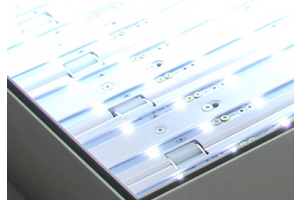Direct-backlit vs. edgelit lightboxes
There are two types of lightboxes used for displaying backlit graphic film. There are what we call direct-backlit lightboxes, and then also what are known as edgelit lightboxes. Here we have a direct-backlit lightbox, which is designed the way most people would expect a lightbox to be. You can see that its lamps are oriented behind the viewing surface, so that the light shines directly forward, through your backlit graphic film.
Over here, we have what we call an edgelit lightbox. In this design, the lamps shine sideways thru the translucent panel behind your graphic film, thereby indirectly lighting up your graphic message.
So… which of these two lightbox designs will work best for your project? Let’s take a look at the pros and cons of both direct-backlit, and edgelit, lightboxes.
First, direct-backlit lightboxes are usually brighter than edgelit ones, because the light is transmitting directly from the lamps to the graphic surface, not shining sideways. This does not mean that edgelit lightboxes are not bright enough for most applications. Consider it like this: most direct-backlit lightbox models have the potential to be slightly brighter than average — depending on some other factors such as how many lamps are used — whereas most edgelit lightboxes usually give you more of a standard-level brightness.
Another difference between direct-backlit and edgelit lightboxes is — a direct-backlit lightbox requires more cabinet space behind the graphic, in order to transmit the light uniformly through the empty space. Usually two to four inches deep is the minimum cabinet depth required to achieve adequate diffusion of light. On the other hand, your average edgelit lightbox can often be less than one inch deep, since the light is transmitted indirectly from the side edges, as we see here.
The next thing to consider when comparing direct-backlit and edgelit lightboxes is what we call “uniformity of diffusion”. Uniformity of diffusion is basically the question of, how uniform or even is the brightness — or intensity — of your lightbox, from one corner of the display to the other. A direct-backlit lightbox will always have the potential to deliver better uniformity than an edgelit one.
For example, check out this direct-backlit lightbox and notice how even the light intensity is spread across the entire face. Now take a look at this edgelit lightbox and notice the slight “glow” along the edges where the lamps are positioned. Almost all edgelit lightboxes exhibit this characteristic. In addition to this, as you increase the size of an edgelit lightbox, the brightness toward the middle of your graphic may start to drop off and get dimmer. This is because the larger the lightbox, the further away the lamps are from the center of the backlit graphic film.
The final consideration between direct-backlit and edgelit lightboxes is your investment. A direct-backlit lightbox needs many more lamps to light up the display surface than an edgelit one, if it’s using LED lamps. For example, a medium-size direct-backlit lightbox may contain approximately eight hundred LED lamps while a similar edgelit lightbox may contain only about one hundred lamps.
This means there will be higher startup and operating investments for the direct-backlit option — that is, unless you choose fluorescent lamps. Considering all these factors, both Direct-Backlit and Edgelit lightboxes have their advantages and disadvantages. But hopefully this will enable you to make the best selection for your project.
| direct-backlit | edgelit | |
|---|---|---|
| brightness | x | |
| low profile frame | x | |
| uniform diffusion | x | |
| jumbo display sizes | x | |
| energy use | x | |
| upfront investment | x |







